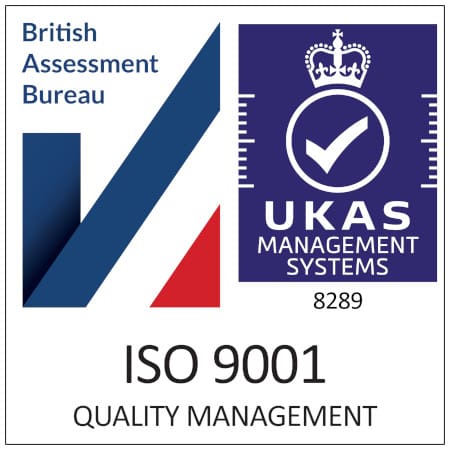Ruby Fluorescence Measurement for High Pressure
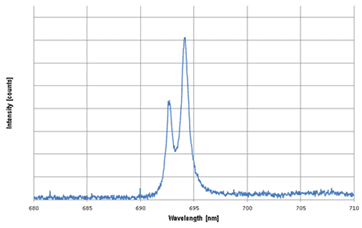
Ruby has long been used in high pressure experiments as a pressure sensor. It exhibits strong fluorescence signal centred around 692.8 and 694.25 nm at ambient pressure (R2 and R1 lines, respectively) and shifting towards the red end of spectrum upon increasing pressure. This pressure dependence was calibrated in 1986 by Mao et al.i and since then has been refined several times by other researchers.

Ruby crystals consist of corundum (Al2O3):Cr3+ with some chromium ions substituting aluminium atoms occupying sites with octahedral symmetry. Due to crystal distortions and spin-orbit coupling effects the electronic levels in atoms are split into several sub-levels. Fluorescence occurs when a system absorbs the radiation and then re-emits light at a different frequency (usually lower) than the frequency of the light absorbed. The energy levels illustration shows the scheme of fluorescence.
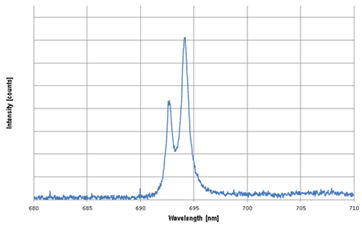
Typical fluorescence spectrum when the Ruby sample is excited by a green laser (532nm) or blue laser (450nm) is shown in the figure on the right hand side. Almax easyLab supply some ground grains in ampoule containing around 200mg of small grains of variable size between 5 and 50 microns in size. The optical grade of the starting Ruby and the annealing process is important to provide a good intensity of the Ruby peaks (R2 and R1 lines) as well as a well-defined two peaks. It has been demonstrated that such annealing process is important to avoid internal strain in the Ruby which in turn provides a reliable pressure calibrant. All Ruby from Almax easyLab has been annealed during more than 30 days to provide the best quality. The FWHM of the R1 line has been measured as around 0.8nm at room temperature and ambient pressure.
Pressure determination is done by using the calibrated shift of R1 line. The widely used Mao scalei gives the following equation for the pressure calculation based on the R1 line wavelength. This form of equation is now accepted as the basis for high pressure measurements and only parameters A and B are modified. Mao scale uses A=1904 and B=7.665; other scales have been proposed. The extensive review of the subject was given by Syassenii.
R1 and R2 lines become very broad and their splitting changes under non-hydrostatic pressure conditions. The intensity of signal also drops significantly as the pressure increases. Therefore, ruby fluorescence shift is limited to its use as a pressure measurement tool to the pressures of about 100 GPa (1 Mbar). Other methods shall be employed at the higher pressures.
P = A/B * [ (λ/λ0)B -1 ]
In experiment, any light with the energy greater than the fluorescence transition can be used to excite fluorescence. One usually uses green or blue laser to excite ruby fluorescence, the latter producing more intense signal.
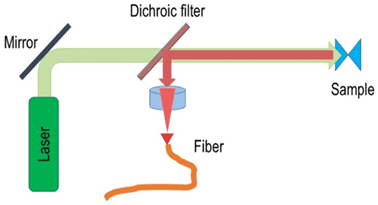
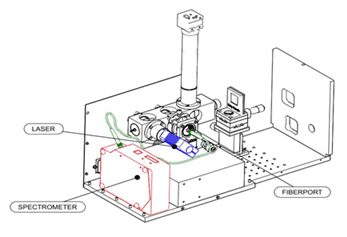
Picture above illustrates how the fluorescence signal is obtained and sent to the spectrometer in Almax easyLab Optiprexx PLS system. Green arrows show the laser light path to the sample (not shown) and red arrows indicate the signal path towards the optical fibre, which then transfers the signal to the spectrometer. Almax easyLab can supply two main different optical system for fluorescence measurement: The Optiprexx PLS and the RubyLUX. Whereas the Optiprexx PLS addresses more the need for a benchtop system, the RubyLUX offers a more small footprint option making it suitable for mounting on stereomicroscope or XYZ stages for beamline application for instance. More information available at www.almax-easyLab.com or by contacting us at sales@almax-easyLab.com.
The following comparison table gives you an overview of the commonalities and differences between these two optical pressure measurement systems:
| Optiprexx PLS | RubyLUX | |
|---|---|---|
| Green Laser | √ (532 nm, 20 mW) | √ (532 nm, 20 mW) |
| Blue Laser | √ (450 nm, 40 mW) | √ (450 nm, 40 mW) |
| Portable | × (benchtop) | √ |
| Signal Level | √√√ | √√ |
| Sample Positioning | √ XYZ Stage | × (microscope of external XYZ Stage) |
| Dimensions | 430 x 368 x 182 mm | 238 x 129 x 80 mm |
| Weight | 7.5 kg | 1.5 kg |
| High Pressure Manager | √ | √ |
| Interlock | √ (optional) | × |
| Sample Observing Eyepiece | √ | × |
| Camera | × (optional) | √ |
| Fibre Port (optional) | √ | √ |
| Working Distance | 23 mm (other on request) | 55 mm (1) cryostat version –
60 mm stereomicroscope version |
(1) Can be customized, but at the expense of magnification (larger working distance leads to smaller magnification)
RubyLUX can be coupled to a cryostat or a microscope.
Optiprexx can be obtained with enclosure to make it a Class 1 laser product.
References:
i) H. K. Mao, J. Xu, and P. M. Bell, J. Geophys. Res., 91, V.5, pp. 4673-4676, (1986).
ii) K. Syassen, High Pres. Res., 28, 75-126, (2008).

